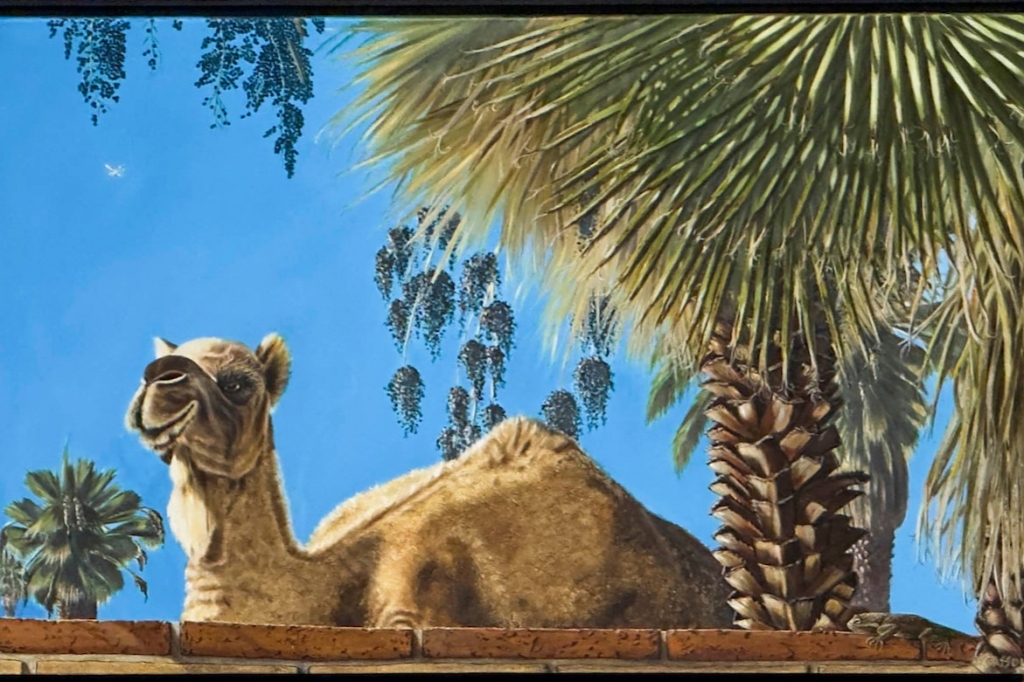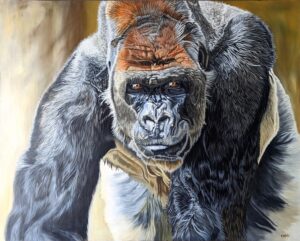Brushes with Wildlife

Conservation Meets Canvas at the Phoenix Zoo
Writer Joseph J. Airdo // Photography Courtesy of the Phoenix Zoo



In a serene corner of the Phoenix Zoo, a massive gorilla gazes intently from a canvas, its expression captured in dramatic light and shadow. Nearby, a lifelike wolf stands sentinel against a snowy backdrop, rendered so perfectly in pastel that visitors mistake it for a photograph. These masterpieces aren’t just art — they’re ambassadors for conservation, part of a thoughtful program that’s changing how visitors engage with wildlife both global and local.
Art on the Wild Side, the Phoenix Zoo’s innovative art initiative, currently showcases two distinct exhibitions that invite visitors to view wildlife through fresh perspectives while supporting the zoo’s conservation mission.
“Our mission is to support animals and their habitats by providing experiences that inspire people to care about the natural world,” explains Jean Bingham, Art on the Wild Side Committee chair and Phoenix Zoo board trustee since 2008. “Like any organization, we’re always looking for ways to reach new people because conservation is so important to the Phoenix Zoo. It’s really the fundamental element of the zoo’s mission.”
The program’s centerpiece, “Society of Animal Artists Presents: A Boundless World,” transforms the Wild Side Gallery near the zoo’s entrance with works from an elite international collective of wildlife artists. Meanwhile, in the air-conditioned comfort of the Savanna Gallery (formerly Savanna Grill), “Arizona Urban Wildlife: Surviving a Complex World” explores the delicate balance between humans and local wildlife in our rapidly expanding urban environment.
“The art program offers multiple benefits,” Bingham says. “It brings new people to the zoo to see our beautiful artwork and helps us collaborate with artists in the community who then become interested in our conservation work. It helps us spread our message of conservation to new audiences while providing a more enriching experience for all our guests.”
Global Perspectives
The Society of Animal Artists exhibition features approximately 400 members whose work undergoes rigorous selection criteria. The society’s origins trace back to the Bronx Zoo in New York about 30 years ago, creating a natural synergy with the Phoenix Zoo’s mission.
“These are truly exceptional artists who specialize in depicting animals,” Bingham notes. “Their mission aligns perfectly with the zoo’s: getting people to care about the animal kingdom and their habitats, and inspiring action to help conserve them.”
The exhibition’s opening reception attracted 12 to 15 participating artists who traveled to Phoenix specifically for the event — impressive for an international group. Visitor response has been enthusiastic, with several pieces already sold. A percentage of all sales returns to the zoo, supporting its operations and conservation programs.
“The feedback I’ve received consistently highlights the exceptional quality of the artwork,” Bingham says, “which really reflects the Society of Animal Artists’ rigorous curation process for their membership.”
Among the standout pieces is “Bird in Hand” by Kim R. Diment, an oil painting of an ocelot spotted in Costa Rica.
“Her use of light in depicting the ocelot is remarkable,” Bingham describes. “There are feathers floating down that the ocelot is looking at, and the way the light shines on both the feathers and the ocelot, with greenery framing the scene, creates a captivating composition that draws viewers into this intimate wildlife moment.”
Equally impressive are the works showcasing extraordinary technical skill. “Passing By” by Lucrezia Bieler measures about 10 inches square and depicts a roadrunner running through prickly pear, crafted from a single piece of black paper on a white background.
“When you see it up close, you’ll be amazed that anyone could create such intricate art from a single piece of paper without making a single cutting mistake,” Bingham marvels.
Another cut-paper piece, “A Well-Behaved Beast” by Tiffany Miller Russell, features a multilayered, three-dimensional mandrill.
“The craftsmanship in these cut-paper works is simply amazing,” Bingham says.
This year’s exhibition continues the program’s recent inclusion of three-dimensional art, featuring 12 bronze sculptures displayed in the protected gallery space. “The Guardian” by Kim Chase — a huge gorilla portrait — commands attention for its dramatic use of light and striking contrast of dark and light tones. Meanwhile, “The Sentry” by Alex Fleming showcases a wolf against a snowy background, rendered with such precision in pastel that viewers often mistake it for a photograph.
Each artwork is accompanied by a caption card where artists share their inspiration — perhaps where they observed the animal or why it held significance — adding a personal depth to the viewing experience.
Local Connections
While “A Boundless World” presents global wildlife perspectives, “Arizona Urban Wildlife: Surviving a Complex World” hits closer to home, examining the complex relationship between humans and wildlife in our state’s expanding urban areas.
“What we’re trying to bring to our guests’ attention is how we’re really taking over many urban spaces that wildlife depends on,” Bingham explains. “We need to be sensitive to that and protective of those creatures living side by side with us in our backyards. We need to understand their needs and how they’re trying to survive alongside humans.”
The exhibition highlights conflicts and coexistence — from coyotes entering backyards to birds striking buildings — and emphasizes Arizona’s crucial role as a migration corridor along the Western Hemisphere from South America to Alaska.
“Our artists have depicted these relationships — some quite whimsically,” Bingham says. “We have beautiful photography of coyotes in drainage pipes and eagles sitting on light poles and similar urban perches. These are wonderful scenes we’ll encounter right where we live. We hope people will appreciate and care about that wildlife and take action to help protect it.”
Among the urban wildlife exhibition’s highlights is “Jamaal Amidst the Washingtonia Filiferas” by Deborah Cassolis, a large painting selected through a juried call for submissions.
“You might not think of a camel as urban wildlife,” Bingham notes, “but Arizona actually has a fascinating history with these animals. They were brought here more than 100 years ago to serve as pack animals across the desert. When they became difficult to manage, many were released into the wild.”
The exhibition also features striking depictions of birds and coyotes navigating urban environments. One particularly memorable painting shows a coyote standing atop a car, while others depict the animals peeking around buildings. Photographs of hawks and eagles perched on telephone poles and streetlights further illustrate wildlife adaptation to human infrastructure.
Art as Respite
Beyond their artistic merit, these exhibitions enhance the overall zoo experience by offering moments of reflection and respite.
“I have a good friend who has grandchildren, and she comes to the zoo all the time,” Bingham shares. “She absolutely loves going into the Wild Side Gallery because it’s a quiet, cool, restful space.”
The gallery includes engagement activities for children, including drawing opportunities and a display wall for their artwork.
“When you come to the zoo, it’s a very sensory experience,” Bingham explains. “You use your eyes, your nose, your ears. In some cases, you can use touch and experience the animals in their very natural-looking habitats. Then you can come over to the gallery and have a little quiet time, a little respite.”
Similarly, the Savanna Gallery transforms dining into an art experience.
“Having your lunch surrounded by beautiful artwork as opposed to just blank walls, which were there before we started this program six years ago, creates a more enriching experience,” Bingham notes. “We’ve observed children going through the grill and choosing the table they want to sit at based on what art is hanging above it. The kids are really getting into it, which thrills us because conservationists are developed young, and if the artwork helps with that, all the better.”
Bingham’s passion for the program stems from her longstanding connection to the Phoenix Zoo. A member since 1988, she maintained her membership through a 20-year absence from Arizona, returning to serve on the board of trustees in 2008.
“My passions are centered around the animal world, their habitats and preserving those habitats in the wild,” she explains. “I’m truly inspired by and in love with the entire animal kingdom. This program offers something different. We have a great committee of talented people — artists, photographers and other volunteers—who work with zoo staff to produce these wonderful exhibits.”
New Horizons
The art program coincides with exciting developments at the Phoenix Zoo, including the opening of the Big Cats of Arizona exhibit.
“That’s a brand-new home for our jaguars and mountain lion, including a pathway over the top of the visitor trail,” Bingham enthuses. “You might have the opportunity to walk underneath a jaguar while it’s crossing overhead!”
The zoo also recently opened Predator Passage, a new Africa exhibit featuring lions, hyenas, a leopard, vultures, fennec foxes and meerkats. The Wild Side Gallery itself represents adaptive reuse at its finest — a refurbished mid-century modern building that previously served as an off-campus utility structure, now transformed into the art program’s centerpiece.
“I think with our mission of caring for these animals and hoping to inspire people to care about them too — by having the animals on exhibit so people can see them and fall in love with them, plus that added element of beautiful artwork depicting them in their habitats — it creates a really great, well-rounded experience when you visit the Phoenix Zoo,” Bingham reflects.
Through Art on the Wild Side, the Phoenix Zoo offers a unique opportunity to connect with wildlife on multiple levels — observing real animals in thoughtfully designed habitats, then experiencing artistic interpretations that might reveal different dimensions of these creatures’ existence. In the process, visitors gain a deeper appreciation for both art and wildlife conservation, carrying that awareness beyond the zoo’s boundaries and into their daily lives.
Society of Animal Artists Presents: A Boundless World
Through May 25 // Thursday–Sunday // 9 a.m.–1 p.m. // Wild Side Gallery
Arizona Urban Wildlife: Surviving a Complex World
Through June 29 // Daily // 9 a.m.–5 p.m. // Savanna Gallery
Phoenix Zoo // 455 N. Galvin Parkway, Phoenix // $39.95; discounts available // 602-286-3800 // phoenixzoo.org

